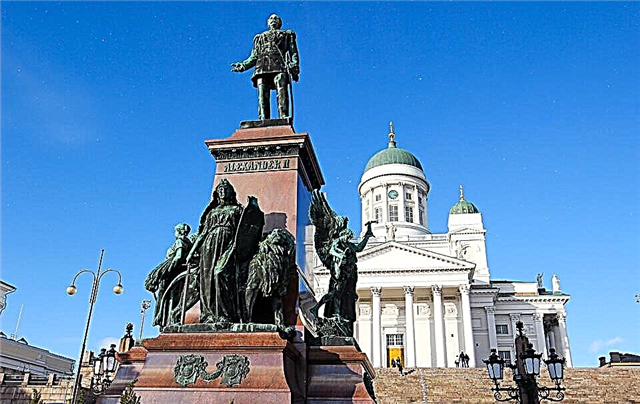Address: Russia, St. Petersburg, Sampsonievsky prospect, 41
Building: 1728 - 1740
Architect: Pietro Antonio Trezzini
Coordinates: 59 ° 58'06.2 "N 30 ° 20'34.5" E
Object of the cultural heritage of the peoples of the Russian Federation
Content:
Each of the cathedrals and churches of St. Petersburg has its own history and dedication. The old Sampson Cathedral is no exception. Its architecture combines features of pre-Petrine and European architecture, so the picturesque building differs from other St. Petersburg churches. Today it is a functioning Orthodox church and a monument-museum, where excursions for tourists are held all year round.

General view of the Sampson Cathedral
Temple history
In 1709, Russian troops led by Peter I defeated the Swedes at Poltava. This event took place on June 27 - the day the Orthodox Church commemorates Saint Sampson.
After returning to St. Petersburg, the emperor took part in the laying of a wooden church, which, in gratitude for the victory, was dedicated to St. Sampson the Host. The new church was erected on the outskirts of the city, near the road leading to Vyborg and Sweden.
During the reign of Queen Anna Ioannovna, it was decided to build a stone church on the site of a dilapidated wooden church. It is believed that the project of the building was carried out by a talented architect and a recognized master of the Baroque style - Pietro Antonio Trezzini. Part of the money for the temple was donated by a merchant from Yaroslavl I.A.Lapshin, and the rest was taken from the treasury.

View of the Sampsonievsky Cathedral from Bolshoi Sampsonievsky Avenue
The construction took over 10 years and was completed in 1740. Initially, the cathedral was single-domed, but in the 1760s, four more domes were added around the main dome.
Until 1711, residents of the city were buried next to parish churches or near houses. Then, at the Sampson Church, two city-wide cemeteries were laid out - for Orthodox Christians and non-believers - Catholics, Lutherans and representatives of other religions. Places for graves in city-wide graveyards were provided free of charge.
It is noteworthy that the idea of a cemetery for foreigners came from Peter I. According to the emperor, many newcomers worked for the good of St. Petersburg, so it was logical to bury them under the protection of the patron saint of all wanderers - Sampson the Strange One.

View of the Sampson Cathedral from the rear
For a long time in the cemetery church on the Vyborgskaya side, funeral rites and memorial services were held. In 1734, one of the best architects of the early 18th century, Dominico Trezzini, was buried here, but his grave has not survived.
As time went on, St. Petersburg grew. To solve the emerging problems, Empress Catherine II initiated several important urban planning reforms. The Empress issued a decree on the transfer of the St. Petersburg churchyards to the suburbs, so in 1785 both cemeteries at the Sampson Cathedral were closed.
In 1830, the temple underwent a major reconstruction. The builders replaced the old cast-iron floors with stone ones and completely renovated the interior of the church.

View of Sampsonievsky Cathedral from Grenadier Street
At the end of the 19th century, a particle of the relics of St. Sampson was transferred from the Panteleimon Church near the Fontanka to the cathedral. At the beginning of the last century, commemorative plaques appeared on the southern and northern facades with the words of Peter the Great, which he spoke to the soldiers of the Russian army.
In 1935, the Orthodox church became an architectural monument. This saved him from destruction during an active anti-religious campaign in the country. Three years later, by decision of the Vyborg Committee, the cathedral was closed for believers and all the bells were removed from the bell tower. Before the war, there was a warehouse and a clothing store inside the building, and in the post-war years - a book depository.
In the 1980s, the old church was added to the St. Isaac's Cathedral. Thanks to this, it was possible to carry out a major restoration. The first visitors were able to see the restored building in 1999, and a year later the cathedral became a monument-museum. The first service was held here in 2002.

Entrance to Sampson Cathedral
Architectural features
The cathedral was completed during the reign of Tsarina Anna Ioannovna, therefore the style in which it was erected is often called the Annensky Baroque. The three-tiered bell tower 35.1 m high is crowned with a slender octahedral tent and an onion dome with a cross. This is how the Orthodox churches in Yaroslavl and Moscow of the 17th century looked like. The second and third tiers of the bell tower are decorated with graceful pilasters of the Tuscan order, and at the very top there is a belfry with a bell from the 18th century.
The one-storey one-absid temple with the western vestibule is painted in a delicate blue-white color. It stands on a strip rubble foundation, has plastered brick walls and a solid limestone plinth. The facades are finished with rusticated pilasters and profiled cornices. The windows of the church are decorated with decorative platbands.
The main volume ends with a high faceted drum and an expressive five-dome. A squat refectory adjoins it. The sloping roof and five domes in the center give the cathedral an unusual look. At the entrance to the temple, you can see a beautiful high relief with angels.

Cathedral domes
In the place where the wooden church used to stand, there is a small beautiful chapel. It was built in 1909 by the Russian architect Andrei Petrovich Aplaksin. The chapel was built in the tradition of the Elizabethan Baroque, therefore it is very different from the temple and the bell tower.
Sampsonievsky garden
There is a picturesque park to the east of the cathedral. The green zone was laid out in 1928 on the site of an old Orthodox cemetery. Until 1991, it bore the name of Karl Marx, and then it was renamed into the Samsonievsky Garden. The shady alleys are a great place to walk. Petersburgers and tourists are happy to come here to relax near a rectangular pond and feed the birds.

View of the Sampson Cathedral from the Sampson Garden
In the Sampsonievsky Garden there is a monument to the first builders of St. Petersburg, which was created in 1995 by the sculptor Mikhail Shemyakin. The names of the architects who took part in the construction of the most famous buildings and avenues of the northern capital are engraved on the granite monument. Grateful residents of the city have immortalized the contribution of famous architects to the construction of St. Petersburg - Andreas Schlüter, Jean-Baptiste Leblond, Domenico Trezzini and Bartolomeo Rastrelli.
Monument to Peter I
To the west of the temple, behind Bolshoy Sampsonievsky Avenue, there is a monument to the founder of the cathedral - Peter the Great. The expressive monument appeared in 1909, when Russia celebrated the 200th anniversary of the Battle of Poltava.

Monument to Peter the Great in front of St. Sampson Cathedral
The bronze statue was cast according to a model created in 1872 by the famous sculptor-realist Mark Matveyevich Antokolsky. The project of the granite pedestal was carried out by the architect Nikolai Evgenievich Lansere. The money for the construction was donated by the great-grandchildren of Field Marshal Boris Petrovich Sheremetyev, who commanded the Russian army near Poltava.
The monument to Peter I stood for 20 years and was dismantled in 1929. The sculpture was sent to the funds of the Tretyakov Gallery, and the granite pedestal was completely dismantled. Only in 2003, when the city on the Neva was celebrating the 300th anniversary of its foundation, the historical monument was restored in its original place.
The Tsar-Reformer is depicted in full growth in the uniform of his beloved Preobrazhensky Regiment. In his left hand, the emperor holds a telescope, and in his right he rests on a massive cane. On the chest of Peter I you can see the Order of St. Andrew the First-Called.

Interiors of the Sampson Cathedral
Interiors and shrines
The nave is 34 m long and 6 m wide. The main value of the cathedral is a huge carved iconostasis 11 m high, which was made in the first half of the 18th century. The famous painters T. Bazhenov, A. Pospelov and A. Kvashnin worked on the icons.
Useful information for visitors
The Sampson Cathedral is an active Orthodox church. Church services are held there daily: on weekdays at 10:00, and on Saturdays and Sundays at 10:00 and 17:00. The entrance is free. A Sunday school for children and adults is open at the church. Tours for tourists are conducted seven days a week: from September 16 to April 30 from 11:00 to 19:00, and from May 1 to September 15 from 10:00 to 19:00.

Monument to the first builders of St. Petersburg against the background of St. Sampson's Cathedral
How to get there
The cathedral stands in the Vyborgsky district of the city, near the Pirogovskaya embankment. Finlyandsky Railway Station is 1.5 km away. It is easy to walk 15 minutes to the temple from the Vyborgskaya and Ploshchad Lenina metro stations. Public transport - buses, fixed-route taxis and trams run along Botkinskaya Street, Bolshoy Sampsonievsky Avenue and Grenadierskaya Street.











